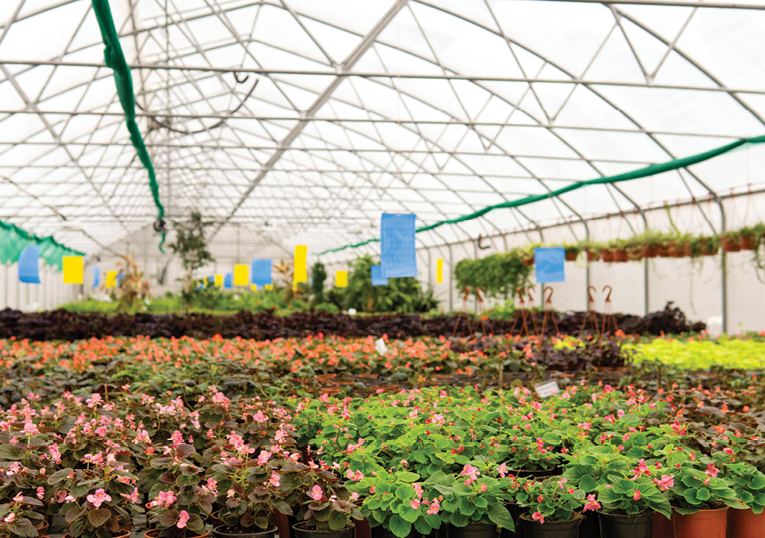
Biopesticides
Pesticides — in this case, insecticides and miticides — are widely used in greenhouse production systems to manage insect and mite pest populations and maintain populations below plant-damaging levels. Some greenhouse producers are minimizing the use of broad-spectrum pesticides and are using more selective or narrow-spectrum pesticides. This article discusses the different types of pesticide selectivity and biopesticides.
Selectivity
There are two types of selectivity: physiological and ecological selectivity. Physiological selectivity refers to greater activity of a pesticide on an insect or mite pest than on a biological control agent (e.g. parasitoid or predator) when both organisms have been exposed to direct contact with a pesticide. Ecological selectivity involves limiting pesticide exposure of a biological control agent through application timing, application method, and or distribution of application. In short, physiological selectivity is a result of physiological differences in the susceptibility of an insect or mite pest and biological control agent to a pesticide. Ecological selectivity is associated with exposure differences between an insect or mite pest, and biological control agent to a pesticide.
Selectivity can also be based on the number of target insect or mite pests that the pesticide is effective in managing. Selective pesticides are active on specific insect or mite pests with minimal direct or indirect effects on non-target organisms such as biological control agents. So, what are the benefits and drawbacks associated with selective pesticides? The benefits include: 1) minimal direct effects to biological control agents, 2) safer to humans than conventional pesticides, 3) less harmful to plants than conventional pesticides, and 4) less persistent in the environment than conventional pesticides. The drawbacks are: 1) narrow spectrum of insect and/or mite pest activity, 2) may indirectly affect biological control agents, 3) minimal persistence (residual activity), and 4) length of time required to kill insect and mite pests is longer than conventional pesticides.
There is overlap between the benefits and drawbacks. In addition, an unintended consequence of pesticides with selective activity is that greenhouse producers still need to manage multiple insect and mite pest complexes. Therefore, greenhouse producers, especially those with multiple cropping systems (polyculture) will mix several selective pesticides together to expand the spectrum of activity against multiple insect and/or mite pest complexes. Consequently, this nullifies the purpose of having selective pesticides. However, if only a single crop is grown (monoculture) with only one insect or mite pest then using selective pesticides may be an option.
Plant-incorporated protectants: Substances that plants produce based on genetic material, which are incorporated into plants.
Biopesticides, in general, are considered selective pesticides, although based on the targeted insect and mite pests on commercially available product labels, this is not always the case. Biopesticides are types of pesticides derived from natural materials, such as animals, plants, bacteria and certain minerals. There are three major classes of biopesticides:

Microbial pesticides: Consist of a microorganism as the active ingredient, such as, a fungus, bacterium, virus, or protozoa, that is selective in activity against specific target insect or mite pests.
Biochemical pesticides: Naturally occurring substances such as semiochemicals that control insect pests by non-toxic mechanisms (e.g. insect sex pheromones).
The general characteristics of biopesticides are: 1) narrow target insect or mite pest activity, 2) complex modes of action, 3) timing of application is important, 4) limited residual activity (persistence), 5) safe to environment and humans, and 6) effectiveness is influenced by environmental factors, such as, temperature, relative humidity, day length, and light intensity. The benefits and drawbacks of biopesticides are listed in Table 1.Microbial pesticides are used in greenhouse production systems to manage certain insect and/or mite pests with the main organisms being entomopathogenic fungi and bacteria. The characteristics of microbial pesticides include: 1) short residual activity, 2) sensitive to ultra-violet light degradation and rainfall, 3) primarily active on the young (immature) stages of insect pests, 4) generally less harmful to biological control agents, such as, parasitoids and predators than broad-spectrum conventional pesticides, 5) low mammalian toxicity, and 6) usually take longer to kill insect pests than conventional pesticides.
Microbially based entomopathogenic bacteria and fungi differ in how they kill insect and/or mite pests. Bacteria must be consumed (stomach poison) by the insect pest. After ingestion, bacteria cause septicemia, which results in death of the insect pest. Fungi can directly penetrate through the insect or mite pest cuticle and initiate an infection. Fungi use a combination of enzymes and mechanical pressure to penetrate an insect or mite pest cuticle. The fungus grows into and proliferates inside the body cavity (hemocoel) of an insect or mite pest with death occurring within four to seven days. Table 2 lists the commercially available microbially based entomopathogenic fungi and bacteria, and plant incorporated protectants registered for use in the U.S.

Explore the September 2023 Issue
Check out more from this issue and find you next story to read.
Latest from Greenhouse Management
- Proven Winners introduces more than 100 new varieties for 2025
- UF/IFAS researchers work to make beer hops a Florida crop
- CIOPORA appoints Micaela Filippo as vice secretary-general
- Passion grows progress
- Registration opens for Darwin Perennials Day
- U.S. Department of Labor finalizes farmworker protection rule
- Azo Root is now available from Harrell’s
- Bidens ferulifolia Blazing Glory





